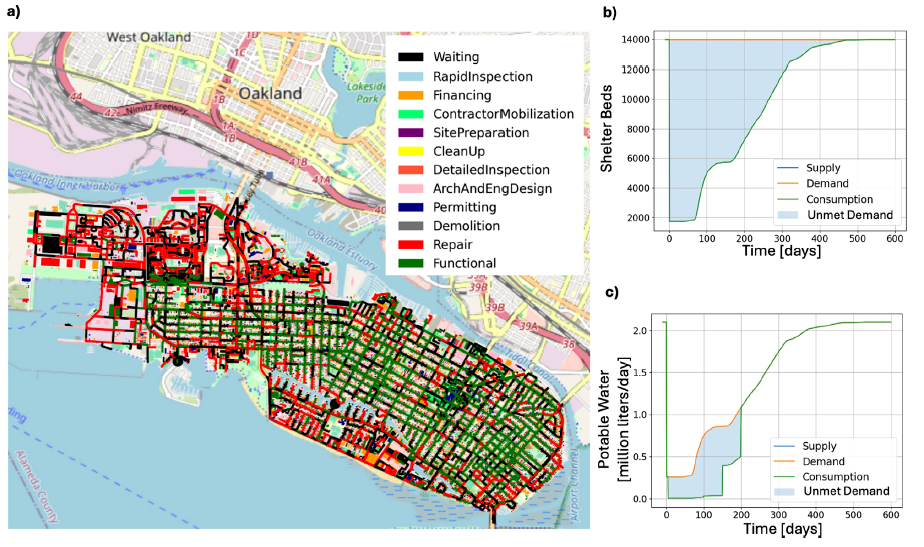SimCenter has just published an article in the journal Frontiers in the Built Environment, Earthquake Engineering, entitled “An open-source simulation platform to support and foster research collaboration in natural hazards engineering.” The article presents the SimCenter’s open-source computational software platform developed to simulate the impact of natural hazards, such as earthquakes, hurricanes, and tsunamis, on the built environment. The platform provides tools that support collaboration across disciplines, leverage publicly available datasets, and integrate widely-used modeling software to study the effect of natural hazards. The SimCenter’s impact on research is substantiated with over 50 citations of studies where SimCenter tools or testbeds were instrumental in achieving research objectives.
 Recovery of housing units providing shelter in part of the San Francisco testbed, considering lifeline and building damages. (a) recovery state of assets 2 months after an earthquake (b) recovery of shelter beds (c) recovery of potable water utility. (Zsarnóczay et al. 2025.)
Recovery of housing units providing shelter in part of the San Francisco testbed, considering lifeline and building damages. (a) recovery state of assets 2 months after an earthquake (b) recovery of shelter beds (c) recovery of potable water utility. (Zsarnóczay et al. 2025.)Important highlights in the article include:
- SimCenter’s open-source applications: These applications are publicly available and extensible, providing access to computational modules tailored for specific research problems in natural hazards engineering. They include tools for regional risk studies (R2D), local-scale structural simulations for various hazards (EE-UQ, WE-UQ, HydroUQ), performance-based engineering (PBE), uncertainty quantification and model calibration (quoFEM), inventory creation (BRAILS++), and damage/loss assessment (Pelicun).
- Developing inventories of the built environment and communities: This involves characterizing assets at risk, such as buildings and infrastructure, which is a critical first step for natural hazard risk analysis. The platform addresses data gaps and enables high-resolution modeling by combining open data acquisition with advanced inference methods, primarily through the open-source BRAILS++ framework.
- Simulating natural hazard events: This capability quantifies the likelihood and severity of natural hazard scenarios, defining regional events through probabilistic Intensity Measures (IMs) that capture the geographic distribution of the severity of an event. The platform integrates outputs from established external models like USGS ShakeMaps and offers efficient, idealized event models within the R2D application for user-defined scenarios.
- Creating asset models for structural analysis and damage estimation: This step determines how assets respond to hazard demands and quantifies resulting damage, leveraging extensive research in various engineering disciplines. The platform supports robust model calibration using experimental data via tools like quoFEM and automates data exchange for scalable workflows, accommodating various levels of simulation fidelity. The Pelicun engine plays a key role in damage and loss assessment, calculating damages using fragility functions.
- Assessing losses, performance, and recovery: The framework extends performance-based methodologies to regional-scale assessments, utilizing high-resolution inventories and damage information to simulate the probabilistic recovery process of affected systems like buildings and transportation networks. It integrates the pyrecodes framework for system-of-systems modeling, managing infrastructure interdependencies and resource allocation for post-disaster recovery.
- Building testbeds to provide benchmarking opportunities for high-fidelity simulations: The SimCenter maintains and develops testbeds (e.g., in the San Francisco Bay Area and Lake Charles) to gain firsthand experience with real-world regional simulation challenges and to evaluate inventory generation models. These testbeds offer high-quality datasets for research, supporting studies on community resilience and risk assessment, and provide platforms to investigate infrastructure interdependencies.
The simulation platform enables multi-hazard, multi-scale simulations, facilitating transparent and reproducible research to inform disaster risk mitigation strategies and resilience planning. By leveraging high-performance computing, the platform aims to provide scalable and adaptable tools to enhance disaster preparedness and response. The article is part of the Research Topic “NHERI 2015-2025: A Decade of Discovery in Natural Hazards Engineering,” and it can be downloaded from https://www.frontiersin.org/journals/built-environment/articles/10.3389/fbuil.2025.1590479/.
Citation:
Zsarnóczay A, Deierlein GG, McKenna F, Schoettler M, Yi S-R, Cetiner B, Satish AB, Zhao J, Bonus J, Melaku AF, Naeimi S, Arduino P, Davidson R, Gorle C, Govindjee S, Kareem A, Kijewski-Correa TL, Lowes LN, Motley M, Spence SMJ, Taciroglu E, Taflanidis AA and DeJong M (2025) An open-source simulation platform to support and foster research collaboration in natural hazards engineering. Front. Built Environ. 11:1590479. doi: 10.3389/fbuil.2025.1590479
 Recovery of housing units providing shelter in part of the San Francisco testbed, considering lifeline and building damages. (a) recovery state of assets 2 months after an earthquake (b) recovery of shelter beds (c) recovery of potable water utility. (Zsarnóczay et al. 2025.)
Recovery of housing units providing shelter in part of the San Francisco testbed, considering lifeline and building damages. (a) recovery state of assets 2 months after an earthquake (b) recovery of shelter beds (c) recovery of potable water utility. (Zsarnóczay et al. 2025.)